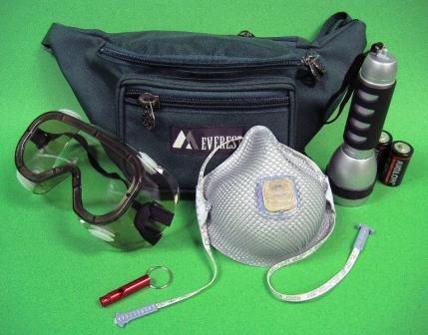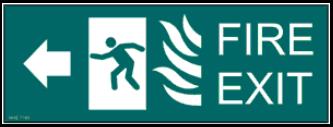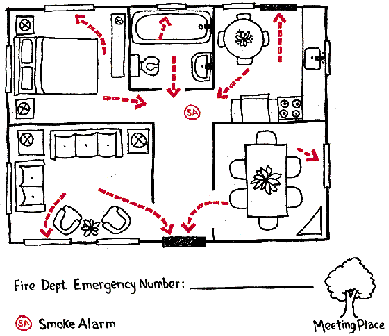|
Does your family have an escape plan? At 2 a.m., Jon and Mary were jolted awake by the sound of the smoke detector upstairs, near the bedrooms of their son Steve, 14, and daughter Molly 10. John and Mary were very worried about their children's safety, but they remembered the fire escape plan that the family had practiced just the week before, and after putting on their bathrobes and slippers, they immediately left the house and went to their family's designated emergency meeting place -- the Miller's house across the street. Jon woke the Millers and asked them to call '911'. Mary watched anxiously for Steven and Molly to join her. The children both knew to keep their bedroom doors closed at night and (if they heard the smoke detector) to check them for warmth, using the backs of their hands, to determine if there was a fire on the other side. Each door felt warm and the children were able to escape through their bedroom windows, as they had practiced, using the fire escape ladders they kept in their closets. They joined Jon and Mary and together the family waited -- safe and accounted for -- until the fire department arrived. Jon's family members survived their house fire because they were prepared. How prepared is your family for fire? Do you have an escape plan that everyone knows and practices? Practicing the 'Great Escape' can save your life! Home fire escape planning can mean the difference between life and death in a fire situation. A typical home fire can become deadly very fast. From the time the smoke alarm sounds, people may have as little as two minutes to escape. This means that everyone in the household must know what to do immediate and that takes planning and practice. How do you make sure that everyone gets out as soon as they hear the smoke detector? · Make sure your smoke detector works. Test it regularly and change the batteries at least once a year. · Train your family to recognize the sound of your smoke detectors and to take that sound very seriously. · Follow your home fire escape plan and meet at a pre-designated location.
Plan Your Escape A home fire escape plan is an emergency plan that you design with your family to identify at least one and possibly two emergency escape routes for every member of your family. Follow the instructions below to develop a fire escape plan for your family. |


|
Designing the Plan · Using a large piece of paper and several colorful markers, draw a floor plan of your home, complete with doors, windows, stairs, and room identifiers. · Using your markers, identify at least one, and preferably two, different ways to exit every room. The first way out would be the door and the second way out could be a window. If you must use a second-story window as an escape route, consider buying fire escape ladders to use as a means of emergency escape.
Practicing the Plan · As you exit your home, close all doors behind you to slow the spread of fire and smoke. · If your primary exit is blocked by smoke or fire, use your second exit to escape. · If you must escape through smoke, stay low and crawl under the smoke to safety. Smoke will rise ot the ceiling, leaving cooler, cleaner air close to the floor. Crawl on your hands and knees, not on your belly, because heavier poisons will settle in a thin layer on the floor. Keep your head 12-24 inches (30-60 centimeters) off the floor. · If you live in a high-rise building, use the stairs - never the elevator - in case of fire. |

|
· Make sure that windows open easily. You wouldn't want to have to break out a window during a practice drill. If your windows or doors have security bars installed, equip them with quick-release devices. · Pick an outside meeting place, far enough away to be safe. A good meeting place might be a tree, telephone pole, mailbox, or neighbor's home. In case of fire, everyone should gather at the meeting place. Make sure everyone can find the meeting place. Once family members start arriving at the meeting place, do a quick check to make sure everyone is accounted for. This way you can tell the firefighters if anyone is still inside. · If you have family members who may need assistance during an emergency escape, be sure to identify a helper. · Once outside, use a cell phone or a neighbor's phone to call 911 and alert the fire department. · Update and practice your fire escape plan at least twice a year. Appoint someone to be the monitor and make sure everyone participates and knows what to do. · Make your escape drill realistic. Pretend that some exits are blocked by fire or smoke and practice using alternate escape routes.
Escape Tips Here are tips to help in escaping the fire: · React immediately to a smoke detector or other fire alarm. · NEVER go back inside a burning building. · Test doors before opening them. Using the back of your hand, feel the door, the door knob and the space between the door and its frame. If any of these are warm, there is fire on the other side of that door -- find another escape route. If they are cool to the touch, very slowly open the door and look outside to see if it's safe.
Remember, a fire drill is not a race. Get out quickly, but carefully. |
|
Home Fire Escape Plan |



